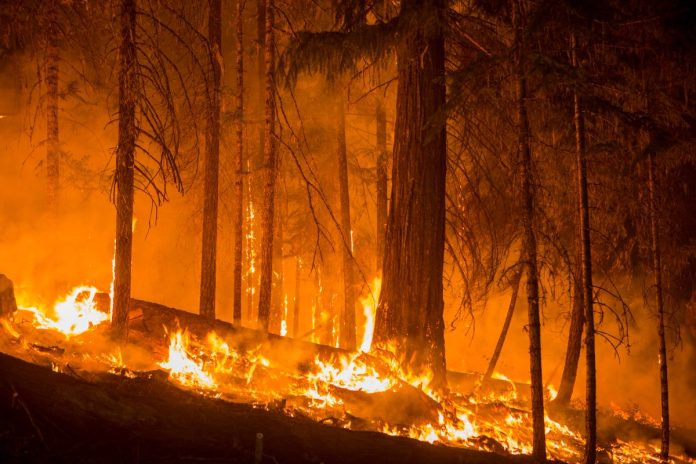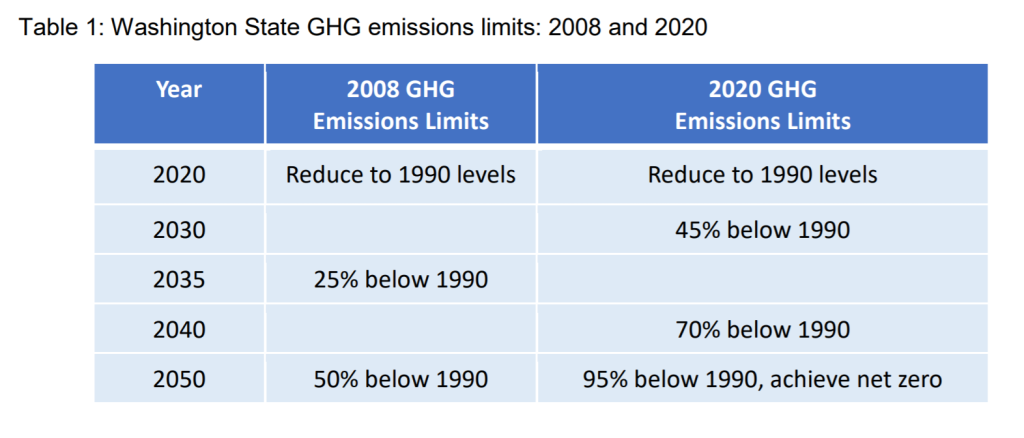
I love numbers.
I was raised by my single mother, a public school teacher and math specialist to love numbers and data, something I still carry with myself today. It shows up in various ways in my life: geometric patterns in my designs, being the first volunteer in a group to calculate a split check (pre-Venmo), and of course, the policy I write. This is why when I organize, even if I see that a number of the groups I normally follow the lead on come out strongly against a proposed policy, there are times where I find myself — like a number of our electeds seem to be — skeptical if what I’m being told is actually the truth. Could a policy named “The Climate Commitment Act” (SB 5126), a cap-and-trade bill, really be that bad? The Climate Commitment Act in its current form is 58 pages long and like any piece of legislation on the environment extremely technical, but I decided to go over the data and put it against my own “sound climate policy” test:
- Will this policy actively reduce emissions?
- Will this policy disproportionately help frontline communities?
- Will this policy effectively achieve all of its goals?
Let’s look at the numbers.
Wait, what even is “cap-and-trade?”
To start, a cap-and-trade system is a method of reducing carbon emissions (a.k.a. pollution) by establishing a “cap” or maximum amount of emissions that can occur over a period of time, allowing polluting businesses under the cap to then sell their (potential) additional emissions to other businesses for a price per ton of carbon dioxide (CO2). Those emitting above the cap pay a fine on the amount they go over, and over time the cap becomes lower and lower, meaning the price for a set amount of pollution in the market (called credits, allotments, or allowances) may rise higher, too.
For our baseline numbers, the most recent emissions numbers put the current total of greenhouse gas (GHG) emissions in Washington to be 99.6 million-metric tons (MMT) of CO2e* (*equivalent). The current goal set by the state legislature is to have a 45% reduction in emissions from 1990 levels by 2030. This would be 49.8 MMT of CO2e, or a 50% reduction from our 2018 levels, according to the Washington State Greenhouse Gas Emissions Inventory 1990-2018.
Will this policy reduce emissions towards our target?
No, and if anything emissions will go up in the short-term, not down.
To start, the implementation date of January 1, 2023 is not true for all industries. This date marks the start of the “first compliance period” (2023-2026), which is followed by a “second period” (2027-2030). The intent of this is to phase in some industries that are heavy polluters and would have to purchase a huge amount of credits and be overly-cost burdened. Some of these delays are fairly straightforward and make sense from an economic perspective:

Electricity providers that import electricity and waste to energy plants are not included until the second compliance period and landfills are not included until after the second compliance period, or 2031. Still, this means that these specific groups of emissions will be delayed from being a part of the overall required reduction.
Industries that are immediately covered by legislation can also qualify for a multitude of no-cost allowances (free polluting credits) and offsets (decarbonize elsewhere for credit against your current or future polluting) so that they can delay and actually pollute over the established “cap.” The number of no-cost allowances in the bill have also increased as the bill has moved through committees, one major one being the inclusion of petroleum refining as eligible to receive an free allocation of allowances during the first period, between 2023 and 2025.
The bill also clearly outlines “emissions-intensive, trade exposed” businesses that get no-cost allocations in order to ensure that a business does not decide to simply leave the state; however the second substitute bill actually expands upon the industries identified in California’s cap-and-trade system (the model for our own bill), and has a provision where the Department of Ecology can also add additional industries before setting rule making. This means there are scenarios where emitting industries could leave California to move here, only for California to then include those exemptions in a race to the bottom that would set us further behind on reducing emissions. This is almost certain to occur, as the current bill plans to link Washington’s system with California’s, allowing trading to occur between the two states.
A number of countries also participate in cap-and-trade systems, so there are non-American examples to learn from in order to make the bill more effective. The European Union Emissions Trading Scheme, which covers 40% of GHGs for all member states of the European Union (EU), was established in 2005. Initially, the allowances and credits were so plentiful that the cost per ton of allowance approached zero, and the initial trading period saw an increase in emissions of nearly 1%. The scheme has been updated and improved, resulting in a total reduction of 35% between 2005 and 2019, however that is 35% of the 40% covered, in other words a 14% total reduction in 14 years. In order to meet our own reduction goals, we must achieve a total reduction of nearly 50% in less than nine years — and that is without airline emissions, which the EU scheme does include.
The first evaluation of the program is also currently allowed to be completed as late as December 31, 2028, meaning that we won’t know until 2029 if we are anywhere near achieving our 2030 emissions reduction target.
Will this policy actively improve frontline communities?
Decidedly, no. At least not any time soon, which is why so many frontline communities and BIPOC-led environmental organizations have come out explicitly against the bill.
Major groups including Front and Centered, a coalition of over 60 organizations, have testified against the bill, stating that cap-and-trade “has not only failed, despite claims to the contrary, but has reinforced environmental racism.” In their letter to legislators, Front and Centered notes that although California’s own system is supposed to account for 50% of all greenhouse gas reductions by 2030, the legislation as it was enacted in 2013 only can be seen as responsible for as little as 5% of emission reductions. Even worse, as stated in a ProPublica article: “most facilities — 52 — increased average emissions within California during the first three years of cap and trade. These include cement and power plants as well as producers and suppliers of oil and gas.” In Washington, these producers are exactly what give frontline communities — disproportionately Black, Indigenous, and other communities of color (BIPOC) — their moniker. The California cap-and-trade system effectively enshrined environmental racism to continue unabated, but the Climate Commitment Act is supposed to learn from these mistakes, correct?
Well currently, the allotments, offsets, and exemptions in the act all line up in a way where the largest emitters in the state can continue to pollute for additional years past 2023. The most notable exemption in my mind is the added “Environmental Justice” review. This review process does not begin until 2025 and although the (complex) review process has enforceable standards for sources of additional air pollution, the required reductions cannot be “disproportionate to their contribution to air pollution compared to other sources of criteria pollutants in the overburdened community.” What this tells me is that there is an interpretation of this rule where a major emitter cannot be forced to reduce their emissions because another emitter in the community is exempted through offsets or other loopholes existing in the bill. Even at the point of recognizing the problem and addressing it, given the amount of time for a review, identification, and direction to the emitter to reduce emissions, frontline communities could be waiting at least another four to six years before current pollution levels are significantly reduced.
Will this policy be effective in achieving its stated goals?
The answer for this one is pretty murky. Yes, it establishes a cap-and-trade system but the current version kicks the can down the road on establishing an actual price on the allotments, creating two challenges: 1) the inability to effectively enforce a system that would in fact deter current polluters from reducing their emissions, and 2) the inability to accurately estimate the amount of revenue that will be received by the state. The bill requires that proceeds be deposited into a new “Forward Flexible Account,” however I cannot find any information that defines what percentage of the price sold will go to the seller of the offset and what portion will be kept by the state. The bill also talks about a “price floor” but does not define how that floor is calculated. The regulation of both tracking emissions as well as operating the auction costs are not clearly defined, so there is no clear horizon as to when the bill will start to generate revenue, only the assumption that it will. I find this concerning given how complex the system is as it stands, not even factoring in the amount of offsets that are currently possible. The current fiscal note shows that the Department of Ecology will hire no less than 40 new full-time employees, to not mention the cost of the bill in other departments or the convening of the advisory panel.
In regards to the revenues that potentially are possible, a recent amendment “directs $650 million each biennium to be deposited into the Forward Flexible Account and the remaining auction proceeds to the Climate Investment Account, for FYs 2022-2037.” Not until fiscal year 2038 and each year thereafter do proceeds increase to 50% into the Climate Investment Account. What this means is the Climate Investment Account will get only about quarter of the amount of funds raised. The rest will go to the transportation budget, which is largely used to build roads and expand highways. In other words, money raised ostensibly for climate may be spent on projects that will increase indirect emissions and could effectively cancel out any potential reductions from this bill. Furthermore, even the money deposited into the Climate Investment Account could be swept to the general fund at any time and used for whatever purpose the legislature deems fit; there are no guard rails currently in the legislation that would prevent that from occurring.
What the legislation does prevent is the creation of “any other type of charge or tax based exclusively on the quantity of GHG emissions” at lower levels of government. This preemption means that implementing any type of local program that would be similar to New York City’s Local Law 97 (building retrofitting) or local goverrnment version of Washington STRONG Act is expressly forbidden. It also prohibits the adoption or enforcement of other programs that would regulate GHG emissions from stationary sources. I can already see a litany of potential suits against the state’s other environmental policies simply because they aren’t allowed under the Climate Commitment Act, including additional gas taxes. It also muddies the waters for the Washington STRONG Act, which focuses on investing in frontline communities through green bonding off carbon tax revenue. Without authority to impose a carbon tax on stationary sources, the STRONG Act would raise far less revenue.
The most glaring issue or preemption in the bill as it stands is failure to tackle indirect emissions, an unfortunate 2020 ruling from the Washington State Supreme Court blocked the Inslee administration from acting via the Department of Ecology, putting the ball in the state legislature’s court. While they opened the door to regulating indirect emissions, the legislature opted to exempt aviation fuels, marine fuels, and on-road fuels, negating some of the value. Indirect emissions covers the state’s largest source of greenhouse gases, transportation, and accounted for nearly 45% of emissions in 2018. This would effectively require the remaining sectors — electricity, residential / commercial / industrial buildings (RCI), fossil fuel industries, industrial processes, waste management, and agriculture — all completely eliminate their emissions by 2030 in order to meet our state target, something that simply will not happen. I call this the gaslighter because this bill both indirectly asks for this to occur and yet the bill as written explicitly does not expect the sectors to decarbonize sooner than 2050.

If The Bill Is Bad, Why Is There Legislative Support?
I believe that, like the average person, many legislators may believe that the bill is currently effective at answering “yes” to the three questions I posed earlier. Even I was convinced at first glance that some good could come of the bill, particularly given the effort to improve the legislation through each committee amendment and substituted version. The Governor is also making this his banner climate bill for the session. The policy sounds promising, appears to be a progressive win, even the brief summary reads as straightforward; there must be a really really good reason to pass it before the end of this session.
But there isn’t. The bill as it is currently written has a litany of complex qualifications processes, manifold offset options, and a number of circuit breakers that prevent the creation of a consistent and strong price on the cost of polluting. This bill somehow manages to take the extremely challenging and technical process of quantifying and reducing emissions and somehow makes it even more confusing. I can say that as someone who works not just on understanding thermal transfer in buildings, but as a former land use code writer, that this is arguably the most difficult to understand piece of legislation that I have ever read. All of which is to say: passing a bill with a great title does nothing if it cannot be enforced in an equal and just manner, let alone an equitable one. In addition, the tradeoffs in this cap-and-trade bill mean that we are locked into this system until 2028, when by then we should have reduced overall GHG emissions in the state by 40% from our 2018 levels. We don’t have time to attempt what other states and countries have failed at, thinking we will get it right this time.
So what should we do instead?
One: kill this bill with fire.
Two: pass something that is clear, enforceable, and drives emissions down by no less than 5% 6.25% each year from 2022 until 2030.
To put this in perspective, when everyone was fully quarantined last April — and the economy at a standstill — emissions only dropped 5.5%. What does this mean? This means in order to meet our climate goals we must achieve structural change to our current systems of energy production, energy use, and most critical in Washington state, transportation. The policy discussion at the state to limit additional emissions is a discussion that should have been done and acted upon in the 1990s. What we must do now is rapidly decarbonize either through government subsidy and/or through putting a high price on the ability to pollute. Doing what will be necessary is not politically popular and the cost is extremely high, but we are now at a point in time where the economic argument around climate inaction is no longer valid. The cost of inaction is much higher, exemplified by the worsening wildfires the West Coast sees each year. Last year’s wildfire season is estimated to have cost between $130 and $150 billion in damages, not including the cost of long-term health impacts, already exemplified by the disparity in life expectancy for frontline communities like South Park and Georgetown, the exact communities that have come out against this bill.
We are now in the 2020s, 30 years after the Growth Management Act was established and the first year of the state’s GHG emissions inventory. The decade for “commitments” to the environment was 20 years ago. This is the decade of the Green New Deal; the decade of true climate action. That action should include scrapping this bill and working on an alternative to truly drive down pollution as quickly as possible. I am already expecting this wildfire season to be longer than the last, and the number of smoke days is only bound to increase through the passage of this bill.
At this point in the legislative session, we are better off with nothing rather than this empty commitment.
Correction: An earlier version of this article stated that the Climate Commitment Act expressly forbids bills like the Washington STRONG Act, which is misleading. The bill limits some of the taxing authority off of which STRONG Act would have bonded, specifically from stationary sources. The bill language does preempt cities and counties from implementing carbon taxes and charges, but doesn’t fully preempt its own future carbon taxes. Additionally, this article has been updated to clarify that the Washington State Supreme Court barred the State Department of Ecology from regulating indirect emissions in a 5-4 2020 ruling. By exempting numerous fuels, the bill language may undermine some the power of regulating indirect emissions, but it didn’t create the original obstacle. Also, added a clarification about credits in the market.
Editor’s note: This op-ed does not denote an endorsement of Houston’s campaign for Seattle Mayor nor does it convey the opinion of The Urbanist. Primary endorsement decisions will be made by The Urbanist Elections Committee in June following their analysis of questionnaire responses and follow-up interviews. In the meantime, other candidates are welcome to submit an op-ed.
Ace Houston is an architect and founder of House Cosmopolitan, an architecture practice focused on celebrating culture and designing places where people belong. Ace is a resident of Seattle, however as a 5th generation Texan also spends time in his adopted hometown of Austin. Ace is running for mayor of Seattle.

